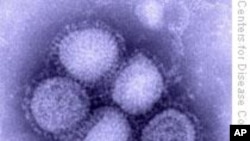The World Health Organization says that since April nearly 5,000 people around the world have died from the H1N1 virus, mostly in the Western Hemisphere. Doctors initially called the virus swine flu because it contained genetic material found in pig influenza, but researchers are now re-thinking not just the names of these viruses, but the way they look at them, too.
In the U.S., health centers have received at least 23 million doses of the vaccine for the H1N1 flu, and they are still facing shortages. Scenes like this one are common -- people willing to wait hours to get their children immunized.
Kathleen Jenkins pitched a tent the night before the the clinic doors opened to make sure her children got the vaccine.
Children and pregnant women so far are the focus of the vaccinations.
"It's not about me," Kathleen Jenkins said, "it's about taking care of my children."
Despite its initial name, H1N1 is not transmitted from pigs to humans. Farmer Paul Zimmerman says he wishes the virus had gotten another name. "How did the swine industry get a bad rap on this? I wish we could have called it the Venezuelan flu when it first came out or something," Zimmerman said.
Some pigs in the U.S. eventually got the virus, but it did not make them sick.
In August, researchers found the H1N1 virus in turkeys in Chile. Researchers concluded the virus most likely was transmitted from man to bird.
In the past several years, people worried about getting the deadly bird flu from infected poultry. And civets, cat-like animals used for food in China, turned out to be the source for a severe respiratory disease called SARS. In the U.S., environmetal scientist Gary Flory worked to prevent the spread of bird flu in domestic poultry. He says it is time to re-think the way diseases are categorized.
"Animal health and human health, they are all related and very much need to be looked at together," Flory said.
Flory says 75 percent of emerging infectious diseases are transmitted from animals to humans or the other way around. And most emerge in Asia where human and animal populations often live close together. He also cites increased travel. "If we have a disease outbreak halfway around the world, it can be in our town within 12 hours," he said.
People are not the only ones traveling. Scientists say exotic pets can spread disease to domestic animals -- or to people. And disease can spread through trade. China recently broadened its ban on pork from the United States. And so-called "mad cow" disease came from sick animals.
"We're selling meat all the way around the world," Flory explained, "and so not only do we have people traveling, we also have animal products traveling."
Add to this mix, the fact that viruses are constantly changing and through the changes, can spread to different species.








